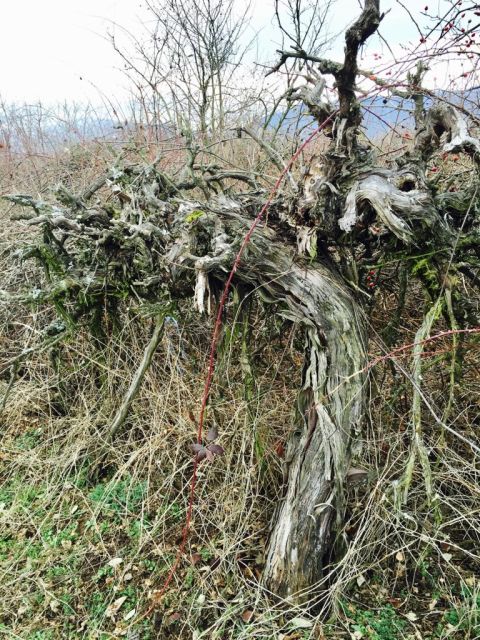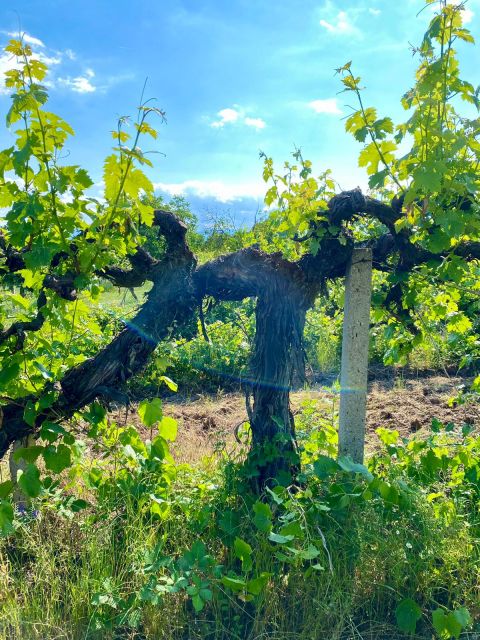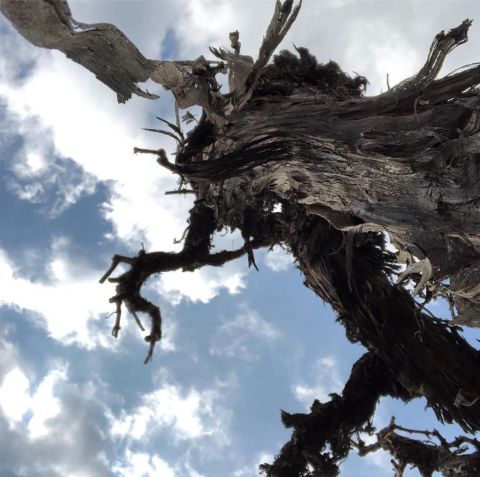‘The vines know no borders or limits.’
It’s a forced deviation from the main road that leads our main characters to their hidden treasure – an abandoned vineyard in Bulgaria that resembles a jungle.
It’s nothing like their usual surroundings in the German region of Rheinhessen. Vines planted in orderly and neatly fashion; vineyards well-maintained by families spanning tens of generations. The ones you all too often read about. The ones that make the front pages of glossy wine magazines. Unlike them, our newly discovered old vine ‘trees’, as our main character calls them, have seen little care. They obsess and possess the space. They portrait chaos and struggle. (And I’d like to think that in small part our main characters identify with them.) But there is peace to be found in the wilderness. It makes a spectacular scene.
First impressed purely by the size of these gigantic vines (they call them “anacondas”), our main characters quickly realise their potential and are soon to turn into their saviours. As it turns out, the timing was just right. The time was pressing. In few short months, this old vine treasure was to be cut for firewood. Some might say, it is almost reminiscent of the Bulgarian government’s stance towards the country’s ancient wine heritage, and turbulent politics resulting in vineyard exploitation, mass production for export markets in the 80s and ultimately land laying in neglect.
But our story is about preservation and hope.
“For the love of wine and nature,” as Velichka and Michael Zehe (pictured at the top of the page) later tell me, they acquired the vineyard in Karabunar, Pazardzhik Province, Upper Thracian Valley in 2010. With it, the Cabernet Sauvignon vines planted in 1970, according to the official register. This was the beginning of a journey that would bring many moving parts together – times, borders, and passions. It also marked the start of Velis Vineyards, or what could be described as a Bulgarian-German winemaking adventure.
Although the climate in the Upper Thracian valley can be very dry and warm, with little precipitation (51mm/m2; 45-year average), Zehe favour low-intervention winemaking. Aiming to enhance concentration in the grapes, they do not to use irrigation, and feel lucky about their stone, sand and clay soils which have high water-holding capacity. The vineyards are well-protected from the Balkan and Rhodope mountains’ slopes but there is good air flow, preventing the risk from diseases, which comes through a V-shaped mountain curve. That same curve is one of the sources of inspiration behind the Velis Vineyards logo.
Zehe tell me that these old vines have found their place. Where they feel most at home. And it couldn’t have happened more naturally. A bit like people – looking for a place to belong.
In the years following the acquisition of the old vines, Zehe not only recultivated these vineyards but also planted additional 36 hectares with French varieties. After hand-harvesting in Bulgaria, the grapes are immediately cooled down and transported in temperature-controlled trucks in 10kg boxes to prevent crushing. Within two days, they have reached the winery in Flörsheim-Dalsheim, where the grapes are sorted and vinified – a village best known amongst collectors for cultish VDP.Weingut Keller and the latest addition and first VDP Sekthaus Raumland. From their Rheinhessen vineyards, Zehe also produce Riesling, Chardonnay and Pinot Noir, with Klaus Scherner (Weingut Scherner-Kleinhanß) at the helm of their winemaking, supported by Clemens Engel (Weingut Engel).
Unlike many in the trade, our characters break away from the notion of wine nationality (which is notably different from ‘terroir’). They see their wine as European rather than Bulgarian or German; and they give themselves room to experiment and play with it. They believe that the vines know no borders – they just need the right conditions. Zehe’s aim is to give the resources to all involved in the process to make exceptional wine.
Nikolay Kovachev is one of those people. As Velis Vineyards’ Senior Agronomist in Bulgaria, Kovachev and his team have been taking care of the Cabernet Sauvignon old vines for the past four years. The ideology behind his pruning and canopy management technique is to keep the old vines’ authentic look. The natural environment is also well preserved. Walnut and cherry trees surround the vines. Scent of poppies and daisies fills the air.
Upon my visit to the Karabunar vineyards in June this year, Kovachev revealed that his father, former Research Associate at the Agricultural Institute, oversaw the planting of all vineyards in the area in the 60s and 70s – including these old vines. In the years following the collapse of the communist regime, the vineyards were returned to their original owners (circa 1999) and have since sunk into oblivion. Driving around the area, on our way to see the Thracian Golden Treasure of Panagyurishte, we spotted more old vine remnants. But not everything can be saved and found.
Thus far, Velis Vineyards have produced two vintages from their old vine Cabernet Sauvignon, 2019 and 2020, both still in barrel in Germany. Kovachev has not tasted the wines yet. Both the 2019 and 2020 wines underwent open-top fermentation and were created by Clemens Engel and Michael Zehe – the people with whom I tasted the wines at Velis Vineyards’ cellar in Flörsheim-Dalsheim in May this year.
2019 was a challenging growing season and harvest in Bulgaria so volumes are small – 375l. “Everything is scarce,” Michael Zehe tells me. But his words feel very different from the popular narrative in fine wine writing, where rarity is romanticised (and the wines always command a premium). The 2019, which will soon be bottled, has dark red colour, displaying hints of menthol, blackcurrant, a slightly supressed oak from being aged in an older barrel, a juicy mouthfeel and soft to medium tannins.
Luckily, the 2020 vintage, a wonderful year for Bulgarian producers, was “plentiful” – close to 700l. The 2020 was another beautiful wine with distinctive eucalyptus, mint and dark chocolate (70%) notes. It will be held in French barriques for circa 14 months prior to bottling.
After tasting various vintages from their old and young vines in both Bulgaria and Germany, I asked Zehe why old vines mattered.
“Only through the old vines can we understand the real potential of the young vines, the terroir and the micro-climate.”
It is not just a question of age or wisdom. This, I thought, is the truest expression of legacy, preservation, and sustainability.
The photos are provided by Desislava Lyapova.



















